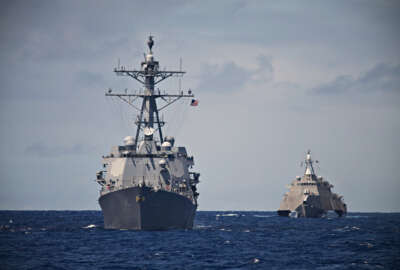Insight by Veritas
DoD Cloud Exchange: Veritas’ Mike Malaret on measuring TCO
Tracking cloud-only consumption at the portal is relatively easy, but how can DoD account for costs as data moves from the cloud to on premises and back again? ...
The services don’t need to rush to put everything in the cloud and should be strategic in what they decide to transfer and in what order, said Mike Malaret, director of sales engineering for public sector at Veritas Technologies, during Federal News Network’s second annual DoD Cloud Exchange.
“When we refer to the data being moved into the cloud, we tend to forget the application usually has to go with it?” Malaret pointed out. “It’s very important that you leverage technologies that are going to be able to give you a comprehensive data protection strategy, be able to restore from within that individual cloud or be able to restore to another cloud — or even be able to restore back on premises.”
Cloud adoption and true cost calculus
This is where the issue of cost versus effectiveness comes in, he said. “What we’ve seen with some of the quote ‘born in the cloud’ solutions is they don’t necessarily scale in a cost effective way in order to bring the most efficiency to the government.” Like many in the military, he highlighted that the decision of how to the use the cloud and when is not all about the hard dollar return on investment.
The goal of the initiatives is about better capabilities everywhere for the services so “it’s important that they look at standardization and cost effectiveness versus on premises versus in the cloud,” Malaret said.
To decide what applications are worth shifting, agencies need to understand the costs of a transition to ensure a controllable pricing model, he said.
“When you’re leveraging only the solutions that are available to you through the consumption of the cloud portal, it’s relatively easy for you to do the cost accounting,” Malaret said. “What we don’t see are solutions designed to be able to do cost accounting that combine the best of bring-your-own license to the cloud, as well as access to cloud capabilities. That’s where a comprehensive reporting solution is really important to be able to analyze those costs associated with the total cost of ownership of an application, both on premises and in the cloud.”
Of course, using multiple platforms — as is necessary in almost all Defense Department environments — makes things more complicated. It’s important to have solutions that span multiple clouds and provide data recovery and protection from one cloud to another, Malaret said. He added that it’s imperative to have a common management interface to keep an eye on this across enterprises end to end.
To listen to and watch all the sessions from the 2022 Federal News Network DoD Cloud Exchange, go to the event page.
Copyright © 2024 Federal News Network. All rights reserved. This website is not intended for users located within the European Economic Area.
Related Stories
Featured speakers
-

Mike Malaret
Director of Sales Engineering, Public Sector, Veritas Technologies, LLC
-

Scott Maucione
Defense Reporter, Federal News Network
On DoD
Upcoming Events
Related Stories
Top Stories

Mike Malaret
Director of Sales Engineering, Public Sector, Veritas Technologies, LLC
Mike Malaret serves as the Veritas Director of Sales Engineering for the US Department of Defense and Intelligence Communities. He is responsible for leading business and technical operations including technical positioning, alignment and development of technologies relevant to the Defense and Intelligence Communities. His scope covers providing advice on topics covering cloud, big data, critical data protection, data security and infrastructure visibility. Working with the Veritas Product Security Group, Product Management and Engineering, Mike has been instrumental on building out Veritas’ Federal Government Security and Compliance practices.
Prior to Veritas Mike worked for Hitachi Vantara (formerly Hitachi Data Systems) as the America’s Chief Technologist supporting Hitachi’s Unified Compute Platform business. Responsibility included driving the strategic direction of the various versions of Unified Compute Platforms, i.e. VMware, Microsoft, Oracle, SAP HANA etc. Mike was additionally responsible for all aspects of sales associated for UCP.
Prior to Hitachi Americas Mike worked for Hitachi Federal as the Chief Technology Officer. As the CTO Mike was responsible for all aspects of engineering within Hitachi Federal. This included all sales engineering and custom development of Hitachi Federal Solutions.
Prior to his time at Hitachi, Mike was the President and CEO of Techpace Inc. Mike created a business that was focused on bringing enterprise capabilities and service levels to the Chicago SMB market. Mike was Emmy Nominated for a Technical Achievement Award where the team developed the first 1000 fps High Definition instant replay system for live Television.

Scott Maucione
Defense Reporter, Federal News Network
Scott Maucione is a defense reporter for Federal News Network and has worked in journalism for over a decade. He previously covered the Pentagon for Inside Defense. He received his B.A. in journalism and political science from the University of Maryland and his Master’s from American University in applied politics.







